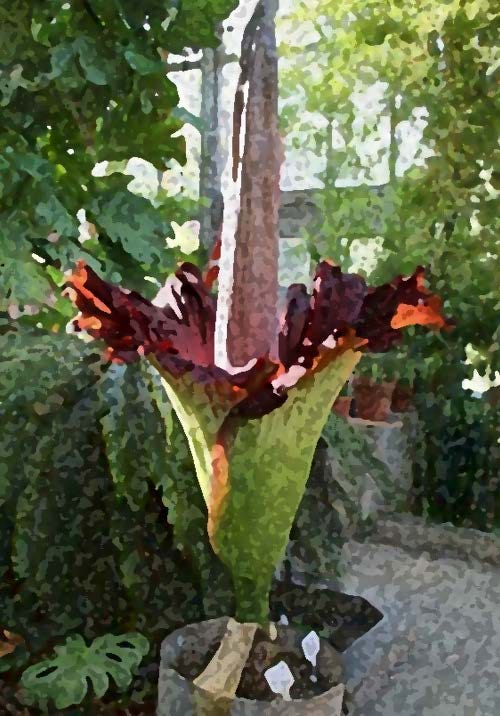Step Right Up, Folks, Don’t be Shy
How to mass market a “rare” smell
While big brain academics debate whether or not perfumes should be considered “art,” a more practical question is whether smell—of any kind—can sell tickets. Sure, there have been museum exhibits with scent dispensers, perfumed performance art, and there’s even a New York gallery for scented artworks. But in most cases, the box office cash stream evaporates as quickly as the scents. Does there exist a reliable market for scent-based entertainment?
There is one such market and it seems to be thriving. It involves a stinky plant and the botanical gardens that promote it.
The plant’s Latin name is Amorphophallus titanum, which literally means “giant misshapen penis.” It is a large Sumatran tuber that every few years puts forth a three- to nine-foot flower stalk, or spadex. The wrinkly purple spadex achieves its full height in a matter of days. At its peak, which lasts a day or two tops, it generates heat as well as the smell of decaying meat. The odor attracts pollinators such as blow flies, flesh flies, and carrion beetles. And also lots of paying customers.
As I wrote in What the Nose Knows, A. titanum
had limited exposure to the public before botanical gardens shared seedlings and made it into the porn star of the vegetable world. Its United States debut was at the New York Botanical Garden in 1937, but its big break came when a blossom at Kew Gardens in London drew 50,000 visitors in 1996. Four television crews reported on the specimen at the Atlanta Botanical Garden in 1998.
The ticket-buying public is clearly fascinated by the plant’s combined elements of the grotesque and macabre. The chumps patrons get a lurid visual and the smell of decaying flesh without having to encounter an actual corpse.
Meanwhile, thanks to two decades of unregulated tuber trafficking in the secretive underworld of Big Botany, the number of public appearances by the stinky stalk has skyrocketed.
You might think an over-abundance of penis plant pop-ups would saturate the market and reduce overall box office. Not to worry. In the fine tradition of P. T. Barnum, botanic gardens cynically promote the blooms as being “rare.” This is a passable half-truth for a given tuber, given that blooms are brief and happen years apart. But across worldwide botanic venues they happen every month or two:
January 8, 2023 - Adelaide Botanic Gardens (“the rare flowering”)
April 3, 2023 - New York Botanical Garden
June 20, 2023 - Indiana University in Bloomington
July 4, 2023 - San Francisco Conservatory of Flowers, Golden Gate Park (“A rare plant”)
July 16, 2023 - Wheaton College, Norton, MA (“rare, notoriously smelly giant plant”)
July 18, 2023 - Missouri Botanical Garden, St. Louis
July 21, 2023 - Mitchell Park Domes, Milwaukee, WI (“rare flower”)
August 6, 2023 - Missouri Botanical Garden, St. Louis (“Rare corpse flower”)
August 30, 2023 - The Huntington Library Botanical Garden, San Marino, CA
February 27, 2024 - California Academy of Science, Golden Gate Park, San Francisco, CA (“the rare corpse flower”)
April 9, 2024 - Dexter, Michigan privately owned specimen. (“rare corpse flower blooming in Washtenaw County”)
April 29, 2024 - University of North Georgia, Dahlonega Campus greenhouse (“rare corpse flower”)
May 19, 2024 - Como Park Conservatory, St. Paul, MN
May 26, 2024 - Plant Growth Facility Conservatory, Colorado State University, Fort Collins, CO (“a rare flower”)
May 28, 2024 - Mitchell Park Domes, Milwaukee, WI
June 6, 2024 - Missouri Botanical Garden, St. Louis (“a rare corpse flower”)
June 12, 2024 - Frederik Meijer Gardens & Sculpture Park, Grand Rapids, MI (“a large, rare flower”)
June 16, 2024 - Chicago Botanic Garden, Glencoe, IL
June 19, 2024 - Princess of Wales Conservatory, Kew Gardens, London
July 11, 2024 - The Huntington Library Botanical Garden, San Marino, CA
July 18, 2024 - Washington State University, Vancouver, WA
July 22, 2024 - U.S. Botanic Garden, Washington, D.C.
July 26, 2024 - Sophia M. Sachs Butterfly House, Chesterfield, MO (“a rare corpse flower”)
August 3, 2024 - Royal Botanic Garden Edinburgh, Scotland (“a rare plant”)
For now, Amorphophallus appears to have legs. But crowds once flocked to the sideshow to see the Bearded Lady or the whole-body tattoos of Horace Ridler, aka the “Zebra Man.” Today, everyone at the gym sports ink and bearded ladies are a dime a dozen on TikTok. It’s tougher to make it on the carnival circuit. We’ll see how long this plant-based craze lasts.


